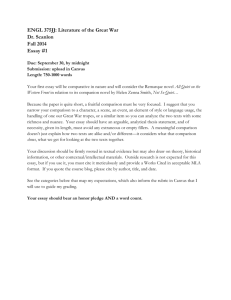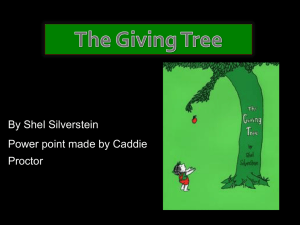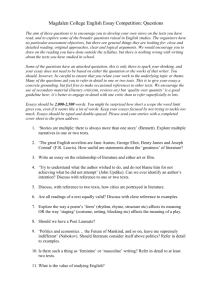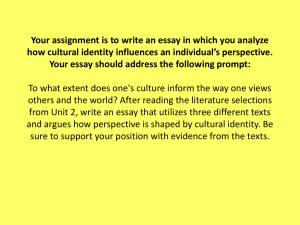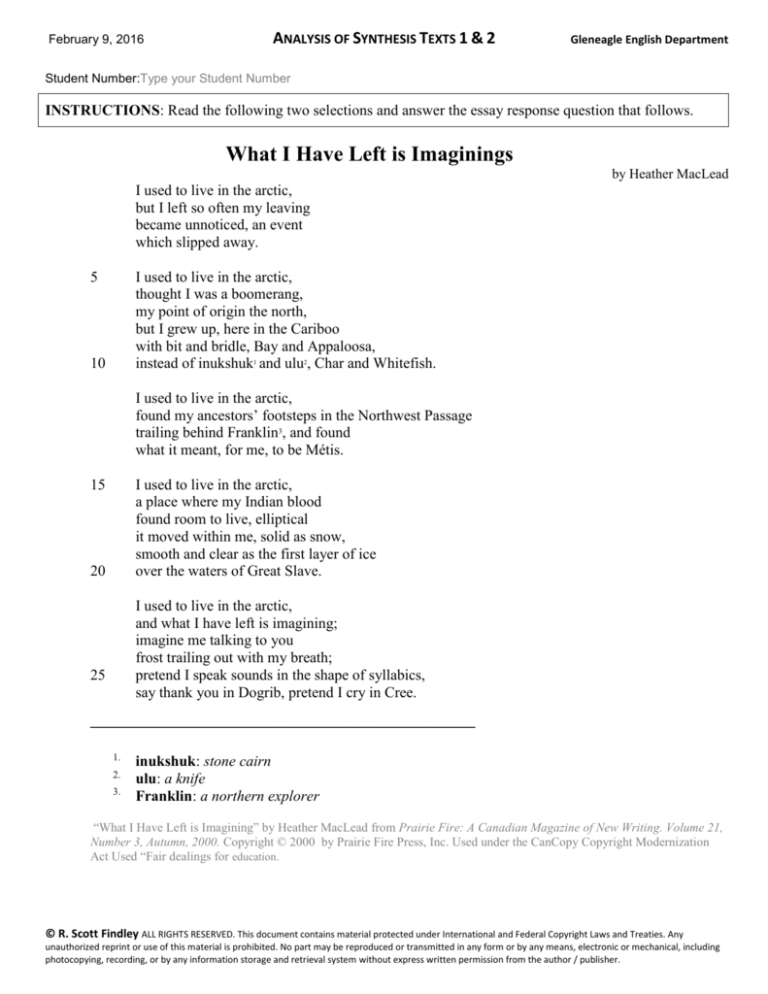
February 9, 2016
ANALYSIS OF SYNTHESIS TEXTS 1 & 2
Gleneagle English Department
Student Number:Type your Student Number
INSTRUCTIONS: Read the following two selections and answer the essay response question that follows.
What I Have Left is Imaginings (04/06)
by Heather MacLead
I used to live in the arctic,
but I left so often my leaving
became unnoticed, an event
which slipped away.
5
I used to live in the arctic,
thought I was a boomerang,
my point of origin the north,
but I grew up, here in the Cariboo
with bit and bridle, Bay and Appaloosa,
instead of inukshuk1 and ulu2, Char and Whitefish.
10
I used to live in the arctic,
found my ancestors’ footsteps in the Northwest Passage
trailing behind Franklin3, and found
what it meant, for me, to be Métis.
15
I used to live in the arctic,
a place where my Indian blood
found room to live, elliptical
it moved within me, solid as snow,
smooth and clear as the first layer of ice
over the waters of Great Slave.
20
I used to live in the arctic,
and what I have left is imagining;
imagine me talking to you
frost trailing out with my breath;
pretend I speak sounds in the shape of syllabics,
say thank you in Dogrib, pretend I cry in Cree.
25
______________________________________________
1.
2.
3.
inukshuk: stone cairn
ulu: a knife
Franklin: a northern explorer
“What I Have Left is Imagining” by Heather MacLead from Prairie Fire: A Canadian Magazine of New Writing. Volume 21,
Number 3, Autumn, 2000. Copyright © 2000 by Prairie Fire Press, Inc. Used under the CanCopy Copyright Modernization
Act Used “Fair dealings for education.
© R. Scott Findley ALL RIGHTS RESERVED. This document contains material protected under International and Federal Copyright Laws and Treaties. Any
unauthorized reprint or use of this material is prohibited. No part may be reproduced or transmitted in any form or by any means, electronic or mechanical, including
photocopying, recording, or by any information storage and retrieval system without express written permission from the author / publisher.
ANALYSIS OF SYNTHESIS TEXTS 1 & 2
adapted from
Taseko (01/11)
by Christian Petersen
1. The rifles, in their leather scabbards, were placed behind the seat of the pickup. The boy’s parents were
talking quietly on the porch, while he waited with Lars in the truck. He was fidgety. At last, his father came
down the steps, carrying his hunting boots which shone with dubbin1. As they pulled out, Mother waved,
especially to her boy it seemed. He almost wished she hadn’t. Like Lars he simply lifted his hand.
2. They drove several hours on the highway, tires whining on the dry, grey pavement, sunshine glinting on the
hood, warm on the dash. The two men spoke about work. He listened to them, and to the fading radio, but
most of his attention was on the land: growth lines dividing the spruce and aspens, rock ridge colours, cattail
ponds and open grassy slopes. West of Lee’s Corner was gravel road and dust. They crossed the Chilcotin
River, then climbed higher up the Plateau. Now, on the crest of a hill, great reaches of country came into
sight, vast dark stands of jackpine, and autumn wild meadows. It was largely untouched, except for
occasional corrals or rail fences sketched into the distance.
3. Lars geared down as they neared a number of plain plywood houses. Long-travelled cars were parked under
the trees, or already half-buried in the weeds. Children came close to the road to watch them pass. Lars
waved, and the kids grinned and ran behind the pickup shouting. Past the houses was a pole corral holding a
half dozen horses. A man stood inside the corral holding an open lariat. He did not turn to the road. The boys,
perched on the fence, looked briefly, but then went back to watching the man with the rope and the horses.
The boy in the pickup twisted in his seat, gazing back until they had rounded the next bend.
4. By late afternoon they were into the first folds of the Coast Range, following a river that was glacial green
and laced with rapids. The road became two ruts worn in scant mountain turf. Lars pointed out a big blunt
peak to the west, called Tatlow, that was sacred to the Tsilhqot’in people.
5. The men had a site in mind for a camp; from there they could cover two adjoining valleys. They stepped out
of the truck into the bite of an icy wind. The boy’s fingers numbed as he helped his father assemble their tent.
As dusk crept quickly westward, the snow on the peaks and in the facial crevices retained the essence of the
day’s light.
———
6. In the morning, frost clustered in the bunchgrass and the juniper needles, and clung in webs against the tires
and fenders of the truck.
7. The boy was first up and made a fire with bone-white branches of pine. Then he dug the charred coffee pot
out of the campbox and took it down to the creek. The boy dipped into the icy stream, then scooted back to
his fire. He sat on his heels with his back to the warmth, hands tucked deep into his coat. A vibrant light rose
above the mountains as the pine sticks snapped in the fire.
8. Lars always hunted alone. This trip he was after a goat, so he worked the higher ridges, sometimes crossing
the patches of grainy snow that had lasted through summer at that altitude. He left early each morning, taking
only rye bread and cheese for lunch, and did not return until dusk.
9. The boy and his father stayed below timberline most of the time, watching the game trails and meadows for
moose or mule deer. They each carried their lunch and a Thermos. On a leather sling over one shoulder his
father had an Enfield .303, with a long black scope. It was accurate at three hundred yards or more. The boy
carried his own Winchester carbine. He was proud of the gun, careful not to scuff it in the brush, but leery
with it too. Lightly he touched the cool lip of the trigger and the gnarled steel hammer end. They stopped
often, to listen, waiting for movement in the woods.
2 of 6
© R. Scott Findley
ANALYSIS OF SYNTHESIS TEXTS 1 & 2
10. Scanning, his binoculars in hand, the boy’s father would point out their next route through alpine slopes and
mossy rock-slides.
11. Each evening his father and Lars spread the map on the tailgate and described the country they had crossed.
Under a kerosene lamp hanging from the truck’s canopy the three of them prepared a meal. Afterward they
settled close to the fire and Lars poured their tea. The boy cupped his hands around the hot drink, listening
closely to the men’s talk and quiet laughter. He was intently aware of when his father spoke. For a moment
he did not recognize that voice, and he did not trust his own. Often, as if he heard something, he looked over
his shoulder. Just there, beyond the firelight, was the wild, an absolute darkness.
12. After four days they had seen no game. Any tracks or sign they found, seemed to be more than a week old,
which puzzled Lars. He had hunted the region for years and had always known it to be rich with wildlife. But
each day it grew colder and perhaps the animals had already moved west or south to lower valleys.
13. Lying in the tent one night, after his father was asleep, the boy heard a low, lasting howl, but the aged wolf
may have been calling from the dark slope of a dream.
———
14. On the morning of the fifth day there were two inches of snow on the ground and the boughs of the pines,
and grey clouds were banked above the mountains, covering the peaks. Over breakfast they had to make a
decision. It was two hours by truck to the good road. If it began to snow again during the day, and continued
for any time, they could have real trouble getting out. However, the snow would allow them to finally
determine if there was any game around, and if there was, today it could be easily tracked. They chose to
hunt one last day.
15. It was tough going. The snow on the dried grass made any incline slippery and for the first time the boy had
trouble keeping up. His boots chafed him. It was cold and he’d worn extra clothing which now had him
sweating. Perhaps his father had wanted to leave that morning; he seemed impatient. He looked gruff with
five days of beard.
16. Not wanting to range too far in the uncertain weather, they checked benches and thickets they had covered on
previous days. The boy’s father hoped to get a deer. He recalled his own first hunting trip, and he wanted
something like that for his son. The boy sensed this. For a time he shared his father’s frustration. But that
afternoon when they turned back for camp, the boy felt only relief.
———
17. A shot ripped the white valley.
18. When the boy started to speak, to ask—his father sharply raised a hand. The man’s attention strained for the
direction of the echo.
19. During those few taut moments—the gun’s report gone, snow and wind rising, spirits moaning in the
timber—in that time the boy first perceived his own unfolding solitude.
20. Another shot. His father headed towards the sound. The boy jogged behind, frightened now by the haste with
which they broke through the brush. His father wanted to find Lars and help him dress the animal. They
stopped in camp to gather some rope and an axe.
21. It was difficult to see the depth of ravines until they had plunged into them. Icy branches clawed at their
clothing. Despite the pace their progress seemed slow and stubborn. Then his father stopped, motioned for
the boy to be quiet, and called out to Lars. A shout from behind them startled the boy.
3 of 6
© R. Scott Findley
ANALYSIS OF SYNTHESIS TEXTS 1 & 2
22. In a few minutes they discovered the hunter in a tiny matted clearing, a moose bed. Lars knelt close to the
dead bull.
23. They cleaned the animal, and his father rigged a rope harness around it. They had to get the meat to camp
that night.
24. The boy looked over at the long head of the moose. When Lars removed the rack, the boy winced. Lars held
them a moment, and then handed them to the boy. The men took up the ropes on the sides of glistening meat.
The boy shouldered the rack and followed them through the darkness.
______________________________________________
1.
dubbin: waterproofing
Adapted from “Taseko” by Christian Petersen. From Let the Day Perish Copyright © 1999 by Christian Petersen. Used under the CanCopy
Copyright Modernization Act Used “Fair dealings for education”
4 of 6
© R. Scott Findley
ANALYSIS OF SYNTHESIS TEXTS 1 & 2
INSTRUCTIONS: In multi-paragraph (3 or more paragraphs) expository essay of at least 300 words answer
the question below in the Response area. Use the Organization and Planning space to plan
your work. The mark for your answer will be based on the appropriateness of the examples
you use as well as the adequacy of your explanation and the quality of your written
expression.
1. Discuss how the speaker in “What I Have Left is Imaginings” would react to the boy’s hunting experience in
“Taseko.”
Put Your Title Here
Type your essay here.
5 of 6
© R. Scott Findley
ANALYSIS OF SYNTHESIS TEXTS 1 & 2
SCORING GUIDE FOR ANALYSIS OF SYNTHESIS TEXTS
This is a first-draft response and should be assessed as such.
The response is assessed holistically.
6
The six essay is superior, demonstrating an insightful understanding of the texts. The essay shows a
sophisticated approach to synthesis, including pertinent references. The writing style is effective and
demonstrates skillful control of language. Despite its clarity and precision, the essay need not be error-free.
5
The five essay is proficient, demonstrating a clear understanding of the texts at an interpretive level.
The essay clearly synthesizes the concepts within the texts. References may be explicit or implicit and
convincingly support the analysis. The writing is well organized and reflects a strong command of the
conventions of language. Errors may be present, but are not distracting.
4
The four essay is competent. Understanding of the texts tends to be literal and superficial. Some synthesis
is apparent. The essay may rely heavily on paraphrasing. References are present and appropriate, but may be
limited. The writing is organized and straightforward. Conventions of language are usually followed, but
some errors are evident.
3
The three essay is barely adequate. Understanding of the texts may be partially flawed. An attempt at
synthesis is evident. References to the texts are not clearly connected to a central idea or may be repetitive.
The response may be somewhat underdeveloped. A sense of purpose may be evident, but errors can be
distracting.
2
The two essay is inadequate. While there is an attempt to address the topic, understanding of the texts or
the task may be seriously flawed. An essay that makes reference to both texts but refers only fleetingly to
one of them is inadequate. The response may be seriously underdeveloped. Errors are recurring, distracting,
and impede meaning.
1
The one essay is unacceptable. Although the essay mentions both texts, the essay is too brief to address the
topic or there may be a complete lack of control in the writing.
0
The zero essay reflects a complete misunderstanding of the texts and/or the task, or is a restatement of the
question. Exclusive reference to only one text does not constitute synthesis. Exclusively narrative responses
reflect a complete misunderstanding of the task.
*Any zero paper must be cleared by the section leader.
NR
A blank paper with no response given.
6 of 6
© R. Scott Findley



